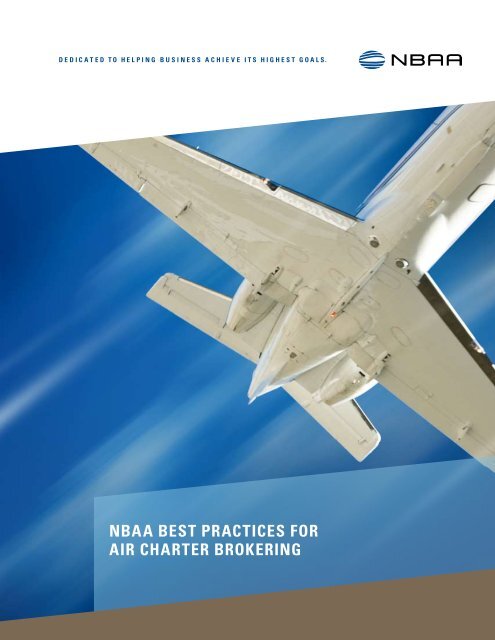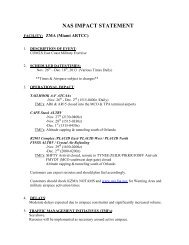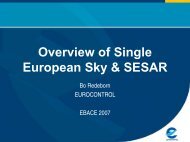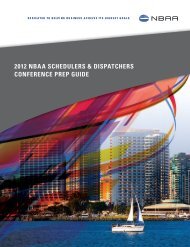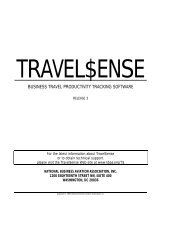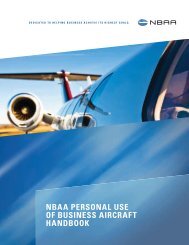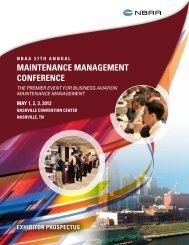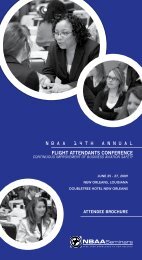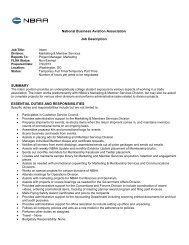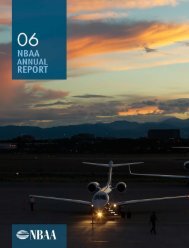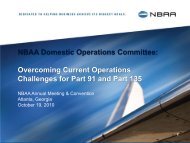Download the NBAA Best Practices for Air Charter Brokering
Download the NBAA Best Practices for Air Charter Brokering
Download the NBAA Best Practices for Air Charter Brokering
Create successful ePaper yourself
Turn your PDF publications into a flip-book with our unique Google optimized e-Paper software.
Dedicated to helping business achieve its highest goals.<br />
<strong>NBAA</strong> <strong>Best</strong> <strong>Practices</strong> <strong>for</strong><br />
<strong>Air</strong> <strong>Charter</strong> <strong>Brokering</strong>
<strong>NBAA</strong> <strong>Best</strong> <strong>Practices</strong> <strong>for</strong> <strong>Air</strong> <strong>Charter</strong> <strong>Brokering</strong><br />
September 2009<br />
Introduction ............................................................................................. 1<br />
What Is an <strong>Air</strong> <strong>Charter</strong> Broker ........................................................... 1<br />
Regulatory Requirements and <strong>Best</strong> <strong>Practices</strong> ................................. 2<br />
General <strong>Air</strong> <strong>Charter</strong> Broker <strong>Best</strong> <strong>Practices</strong><br />
<strong>for</strong> All Four Categories............................................................................. 3<br />
<strong>Best</strong> <strong>Practices</strong> <strong>for</strong> Agent of <strong>the</strong> Customer ........................................ 4<br />
<strong>Best</strong> <strong>Practices</strong> <strong>for</strong> Agent <strong>for</strong> <strong>Air</strong> Carrier ............................................ 6<br />
<strong>Best</strong> <strong>Practices</strong> <strong>for</strong> Broker as Middleman........................................... 6<br />
<strong>Best</strong> <strong>Practices</strong> <strong>for</strong> Broker as Indirect <strong>Air</strong> Carrier............................. 7<br />
Terms and Conditions............................................................................. 7<br />
Aviation Insurance Considerations .................................................... 8<br />
Related <strong>NBAA</strong> and Federal Government Resources....................... 8<br />
About <strong>NBAA</strong>............................................................................................. 8<br />
Credits........................................................................................................ 8<br />
This National Business Aviation Association (<strong>NBAA</strong>) publication<br />
is intended to provide air charter brokers, charter<br />
operators and charter customers with an introduction to<br />
industry-wide best practices related to air charter brokering.<br />
Readers are cautioned that this publication is not intended<br />
to be an exhaustive or exclusive list of practices that may<br />
be employed by air charter brokers, and exceptions to <strong>the</strong>se<br />
practices may be acceptable in specific situations or transactions.<br />
These practices are no substitute <strong>for</strong> <strong>the</strong> advice of<br />
legal and tax advisors addressing a specific set of facts that<br />
air charter brokers may face. Additionally, this version of <strong>the</strong><br />
handbook is dated September 15, 2009, and does not incorporate<br />
any statutes, regulations or guidance released after<br />
that date.<br />
Introduction<br />
<strong>NBAA</strong> recognizes <strong>the</strong> value-added role brokers can play in<br />
arranging air transportation on qualified business aircraft.<br />
<strong>Air</strong> charter brokering has become a significant vehicle to<br />
connect qualified suppliers of air transportation with qualified<br />
customers. While <strong>the</strong> role of <strong>the</strong> air charter broker is<br />
not plainly and comprehensively regulated, a number of federal<br />
and state agencies have oversight of various matters<br />
that air charter brokers encounter on a daily basis. These<br />
matters are discussed in this <strong>NBAA</strong> <strong>Best</strong> <strong>Practices</strong> <strong>for</strong> <strong>Air</strong><br />
<strong>Charter</strong> <strong>Brokering</strong> publication.<br />
This document addresses <strong>the</strong> role air charter brokers play<br />
in <strong>the</strong> Part 135 on-demand air charter industry (focusing<br />
on aircraft with seating capacity of 30 seats or fewer) and<br />
discusses federal regulations that must be adhered to and<br />
<strong>the</strong> best practices used throughout <strong>the</strong> air charter brokering<br />
industry. Fur<strong>the</strong>rmore, it provides in<strong>for</strong>mation that will help<br />
protect air charter brokers in <strong>the</strong> course of <strong>the</strong>ir business.<br />
Throughout this document, <strong>the</strong> term “customer” is used to<br />
represent <strong>the</strong> end consumer who is seeking air transportation<br />
(i.e., <strong>the</strong> person or entity that is <strong>the</strong> charterer of <strong>the</strong><br />
aircraft). <strong>NBAA</strong> urges all air charter brokers to follow <strong>the</strong>se<br />
practices.<br />
What is an <strong>Air</strong> <strong>Charter</strong> Broker<br />
In addition to more than 2,500-plus charter operators<br />
licensed by <strong>the</strong> Federal Aviation Administration (FAA) (also<br />
known as direct air carriers or carriers), <strong>the</strong>re are entities<br />
(companies and individuals) that link prospective charter<br />
customers with charter operators. These entities are known<br />
as air charter brokers. An air charter broker matches a<br />
consumer’s travel needs with available air charter provided<br />
by carriers licensed under Part 135 of <strong>the</strong> Federal Aviation<br />
Regulations (FARs).<br />
<strong>Air</strong> charter brokers may specialize in specific niches (e.g., air<br />
ambulance, long-range or large cabin aircraft) and also may<br />
provide access to o<strong>the</strong>r services, such as trains, hotels and<br />
ground transportation. There also are brokers who service<br />
only certain types of customers (e.g., investment capital<br />
raising “road trips,” speakers’ bureaus, medical flights),<br />
limited types of equipment (e.g., business aircraft, airliners,<br />
helicopters) and/or specific types of flights (e.g., passenger,<br />
cargo, air ambulance).<br />
An FAA-135 licensed charter operator also may broker<br />
aircraft from o<strong>the</strong>r fleets to supplement its own capacity.<br />
<strong>NBAA</strong> urges charter operators that engage in such broker<br />
activities to confirm that <strong>the</strong>y are consistent with <strong>the</strong>ir U.S.<br />
Department of Transportation (DOT) and FAA authority (e.g.,<br />
<strong>the</strong> charter operator registered with DOT as an air taxi is not<br />
offering or holding out an aircraft designed <strong>for</strong> more than<br />
60 seats). <strong>Charter</strong> operators should be up-front with <strong>the</strong>ir<br />
customers when <strong>the</strong>y broker such flights, as <strong>the</strong> customer<br />
should know who <strong>the</strong> direct air carrier <strong>for</strong> <strong>the</strong> flight(s) is.<br />
In <strong>the</strong> air charter industry <strong>the</strong>re are four broker categories,<br />
which are as follows.<br />
Agent of <strong>the</strong> Customer<br />
Those who represent charter consumers (acting as an<br />
agent of <strong>the</strong> customer). The customer contracts directly <strong>for</strong><br />
broker’s services. The contract should explicitly state that<br />
<strong>the</strong> broker is acting as an agent on behalf of <strong>the</strong> customer.<br />
Agent of <strong>the</strong> <strong>Air</strong> Carrier<br />
An air charter broker who serves as <strong>the</strong> marketing arm <strong>for</strong><br />
charter operators (acting as an agent of <strong>the</strong> air carrier). The<br />
broker should have a separate agency contract with <strong>the</strong> air<br />
carrier which, among o<strong>the</strong>r things, defines how <strong>the</strong> broker<br />
will be compensated.<br />
<strong>NBAA</strong> <strong>Best</strong> <strong>Practices</strong> <strong>for</strong> <strong>Air</strong> <strong>Charter</strong> <strong>Brokering</strong> 1
<strong>NBAA</strong> Membership<br />
A True Middleman<br />
When a broker acts as a true “middleman,” <strong>the</strong> broker, at<br />
<strong>the</strong> request of a customer, finds an appropriate charter operator,<br />
with whom <strong>the</strong> customer <strong>the</strong>n contracts directly <strong>for</strong><br />
<strong>the</strong> charter flights. Or, at <strong>the</strong> request of a charter operator,<br />
<strong>the</strong> broker as a true middleman finds customers <strong>for</strong> a flight<br />
or series of flights. In this middleman scenario, <strong>the</strong> broker is<br />
nei<strong>the</strong>r <strong>the</strong> agent <strong>for</strong> <strong>the</strong> customer nor <strong>the</strong> agent <strong>for</strong> <strong>the</strong> air<br />
carrier. The middleman is not involved, in any way, with <strong>the</strong><br />
provision of air transportation, and <strong>the</strong> customer pays <strong>the</strong><br />
broker separately <strong>for</strong> its services.<br />
Indirect <strong>Air</strong> Carrier<br />
When an air charter broker purchases air transportation <strong>for</strong><br />
its own account from a direct air carrier and resells such air<br />
transportation to a customer, it is acting as an indirect air<br />
carrier (IAC). The broker when acting as an indirect air carrier<br />
normally contracts directly with both <strong>the</strong> customer and<br />
<strong>the</strong> charter operator.<br />
Note: As discussed fur<strong>the</strong>r below, in order to act as an indirect<br />
air carrier, a broker must first obtain economic authority<br />
from <strong>the</strong> DOT. The public charter rules in Part 380 of <strong>the</strong><br />
DOT’s regulations provide a category of indirect air carrier<br />
that several air charter brokers utilize. Because Part 380<br />
does not readily lend itself to planeload brokering as an indirect<br />
air carrier, <strong>NBAA</strong> is currently working with <strong>the</strong> DOT to<br />
create a more user-friendly air charter broker procedure <strong>for</strong><br />
small aircraft (designed <strong>for</strong> 30 seats or under), which would<br />
streamline <strong>the</strong> process <strong>for</strong> obtaining IAC-type authority. No<br />
such economic licensing authority is required <strong>for</strong> <strong>the</strong> o<strong>the</strong>r<br />
charter broker classifications.<br />
Regulatory Requirements<br />
and <strong>Best</strong> <strong>Practices</strong><br />
The following are regulatory requirements and best practices<br />
<strong>for</strong> air charter brokering at federal, state and local levels.<br />
Federal Government<br />
Numerous federal regulatory agencies play a role in <strong>the</strong><br />
regulation of <strong>the</strong> air charter industry, which directly affects<br />
charter operators and air charter brokers. They are<br />
<strong>the</strong> Transportation Security Administration (TSA), Internal<br />
Revenue Service (IRS), FAA and DOT.<br />
The TSA regulates certain passenger and cargo charter<br />
flights, and charter operators have TSA-approved security<br />
programs. <strong>Air</strong> charter brokers must know which security<br />
requirements will be in effect in order to prepare passengers/cargo<br />
adequately in advance of a flight. These security<br />
requirements can differ depending on <strong>the</strong> charter operator’s<br />
approved program and area of operations.<br />
Transportation by air is subject to excise taxes, and air<br />
charter brokers may be primarily or secondarily responsible<br />
<strong>for</strong> <strong>the</strong> collection and remittance of taxes to <strong>the</strong> IRS. The<br />
IRS conducts federal excise tax (FET) audits to ensure air<br />
transportation tax collection and remittance, and includes<br />
air charter brokers in audits. The <strong>NBAA</strong> Federal Excise Tax<br />
Handbook describes air transportation and fuel excise taxes<br />
in detail. That document is available to <strong>NBAA</strong> Members on<br />
<strong>the</strong> Association’s web site at www.nbaa.org/taxes.<br />
<strong>Air</strong> charter brokers must be very familiar with a range of<br />
FAA operational regulations and restrictions, such as requirements<br />
<strong>for</strong> certificated charter operators, flight duty and<br />
rest restrictions, and <strong>the</strong> need <strong>for</strong> <strong>the</strong> charter operator to<br />
maintain complete control over its flights/series of flights.<br />
Unlike FAA-certificated charter operators (i.e., direct air carriers)<br />
and IACs, charter brokers acting ei<strong>the</strong>r as an agent <strong>for</strong><br />
<strong>the</strong> customer, an agent <strong>for</strong> <strong>the</strong> air carrier or <strong>the</strong> middleman<br />
currently are not required to be licensed and/or certificated<br />
by <strong>the</strong> FAA or DOT. However, <strong>the</strong> DOT in en<strong>for</strong>cement<br />
policy notices has set certain requirements <strong>for</strong> all air charter<br />
brokers, which are summarized here:<br />
• Brokers must be clear with <strong>the</strong> customer/charterer, as<br />
applicable, in all solicitation materials, verbal and written<br />
correspondence, contractual documentation and wordof-mouth<br />
contact, that <strong>the</strong>y are not <strong>the</strong> FAA licensed<br />
Part 135 operator. The broker cannot create <strong>the</strong> false<br />
impression that <strong>the</strong>y are direct air carriers in <strong>the</strong>ir own<br />
right by, <strong>for</strong> example, referring to an aircraft used in <strong>the</strong><br />
air services <strong>the</strong>y are marketing in a manner that conveys<br />
<strong>the</strong> false impression that <strong>the</strong>y are <strong>the</strong> air carrier. Such<br />
phrases as “our fleet,” “our charters,” “our charter<br />
service,” “our aircraft,” “our crews,” “our flightcrews”<br />
or “we operate a fleet of” have been found by <strong>the</strong> DOT<br />
to create such an impression even if such phrases are<br />
qualified by footnotes or o<strong>the</strong>r disclaimer.<br />
• Brokers may not represent <strong>the</strong>mselves as a principal<br />
in a transaction (i.e., buying or selling air transportation<br />
<strong>for</strong> <strong>the</strong>ir own account) unless <strong>the</strong>y have first received<br />
economic authority from <strong>the</strong> DOT to act as an IAC (see<br />
below).<br />
• It is incumbent upon <strong>the</strong> broker to exercise due diligence<br />
to ensure he or she is arranging <strong>the</strong> charter<br />
service that is advertised. For example, if <strong>the</strong> broker is<br />
acting as an agent of customer, <strong>the</strong> broker must ensure<br />
it is, in fact, placing customers on licensed direct air<br />
carriers. Similarly, if <strong>the</strong> broker is advertising that charter<br />
customers will be placed on audited charter flights<br />
(e.g., “Wyvern-audited,” “ARG/US approved”), <strong>the</strong>n<br />
<strong>the</strong> broker must ensure that <strong>the</strong> charter operator has<br />
met that audit/standard.<br />
State and Local Government<br />
State and local government agency oversight of air charter<br />
brokers will vary from state to state, county to county and<br />
city to city. Some states have seller-of-travel laws and/or<br />
business licensing or registration requirements while o<strong>the</strong>rs<br />
may have none. It is outside of <strong>the</strong> scope of this document<br />
to categorize all state and local government requirements.<br />
However, air charter brokers should, at a minimum, investigate<br />
seller-of-travel laws, business licensing, registration<br />
2 <strong>NBAA</strong> <strong>Best</strong> <strong>Practices</strong> <strong>for</strong> <strong>Air</strong> <strong>Charter</strong> <strong>Brokering</strong>
and insurance requirements, and state sales and income tax<br />
regulations and provide proof of compliance to a customer,<br />
upon request.<br />
All brokers must comply with all state and local laws, including,<br />
as applicable, seller-of-travel laws <strong>for</strong> <strong>the</strong> various states<br />
in which broker is doing business.<br />
General <strong>Air</strong> <strong>Charter</strong> Broker <strong>Best</strong> <strong>Practices</strong><br />
<strong>for</strong> All Four Categories<br />
The following proposed items constitute a set of best practices<br />
<strong>for</strong> all broker types to consider. <strong>Air</strong> charter customers,<br />
who may be considering <strong>the</strong> services of an air charter<br />
broker, also may use <strong>the</strong>se considerations when interviewing<br />
air charter brokers. This may help customers gauge<br />
<strong>the</strong> broker’s expertise and determine if <strong>the</strong> broker has <strong>the</strong><br />
knowledge and skills to meet <strong>the</strong> needs and expectations<br />
of an air charter customer.<br />
• Obtain all necessary state and local business licenses<br />
and/or registrations.<br />
• Have an understanding of <strong>the</strong> various facets of <strong>the</strong><br />
charter industry and <strong>the</strong> role(s) air charter brokers play.<br />
• Be familiar with <strong>the</strong> business aviation industry. <strong>NBAA</strong>’s<br />
web site and o<strong>the</strong>r resources provide an excellent introduction<br />
to issues related to business aircraft ownership<br />
and operations. These resources provide a solid basis<br />
of in<strong>for</strong>mation <strong>for</strong> air charter brokers who might not<br />
have come from a business aviation background.<br />
• Learn <strong>the</strong> various types of aircraft used in business<br />
aviation and, in particular, <strong>the</strong> types of aircraft that<br />
might be requested by your customers:<br />
• Piston vs. Turboprop vs. Turbojet. Which type of<br />
aircraft is <strong>the</strong> right one <strong>for</strong> a particular flight/mission<br />
For instance, a large cabin turbojet aircraft might not<br />
be ideal <strong>for</strong> a one-passenger flight of one hour duration<br />
to a small, remote airport.<br />
• <strong>Air</strong>craft Manufacturers, Makes, Models. One option<br />
might be less expensive per hour, but could take<br />
longer <strong>for</strong> <strong>the</strong> flight, thus costing <strong>the</strong> customer more<br />
in <strong>the</strong> long run.<br />
• Seating Capacities and Limitations. For example, an<br />
eight-passenger aircraft does not always mean that<br />
aircraft has eight full-size seats that com<strong>for</strong>tably sit<br />
an adult. Commonly, one of <strong>the</strong> seats certified <strong>for</strong><br />
takeoff on business aircraft is a “belted potty.” How<br />
would your customer view that if all eight seats were<br />
to be filled on a cross-country flight<br />
• Range Capability of Business <strong>Air</strong>craft (generally presented<br />
in nautical miles; 1 nm = 1.15 statute miles).<br />
Business aircraft design inherently entails trade-offs.<br />
Often a trade-off is made between <strong>the</strong> flight range<br />
and <strong>the</strong> weight of <strong>the</strong> aircraft passengers and <strong>the</strong>ir<br />
baggage. An aircraft with a 1,200 nm range might<br />
make that with two passengers and luggage, but<br />
not with six passengers with luggage. In <strong>the</strong> latter<br />
example, a fuel stop might be required, thus adding<br />
time to <strong>the</strong> trip and expense to <strong>the</strong> customer.<br />
• Be aware that <strong>the</strong>re are governmental regulations and<br />
policies directly regulating charter operators and air<br />
charter brokers, including those implemented by <strong>the</strong><br />
DOT, FAA, TSA, IRS and any o<strong>the</strong>r applicable federal or<br />
state regulatory agency.<br />
• Know that <strong>the</strong> air charter broker cannot influence<br />
operational decisions that only <strong>the</strong> licensed charter<br />
operator can make. There are strict operational control<br />
regulations and policies that <strong>the</strong> FAA en<strong>for</strong>ces and <strong>the</strong><br />
charter operator must follow.<br />
• Stay abreast of regulatory changes and industry trends<br />
by attending industry seminars and through professional<br />
industry memberships.<br />
• In every transaction, including those posted on a web<br />
site, press release, contract or o<strong>the</strong>r <strong>for</strong>m of marketing,<br />
be clear as to whe<strong>the</strong>r <strong>the</strong> broker: (1) represents<br />
<strong>the</strong> customer, (2) represents <strong>the</strong> air carrier, (3) acts as<br />
a true middleman or (4), if authorized by DOT, acts as<br />
an IAC.<br />
• <strong>Air</strong> charter brokers should be aware of insurance policies<br />
that may be secured to protect <strong>the</strong>ir interest and<br />
<strong>the</strong>ir customer’s interest in <strong>the</strong> charter transaction.<br />
• Carry “errors and omissions” insurance in an adequate<br />
amount. Errors and omissions insurance will provide<br />
you with a level of protection in <strong>the</strong> event a dispute<br />
arises between <strong>the</strong> air charter broker and <strong>the</strong> charter<br />
operator or customer. For example, if, as a broker, an<br />
error is made (such as in<strong>for</strong>ming <strong>the</strong> charter operator<br />
of <strong>the</strong> wrong airport location/code), <strong>the</strong> policy could<br />
cover <strong>the</strong> costs associated with relocating <strong>the</strong> aircraft<br />
to <strong>the</strong> proper airport. The policy premiums vary. Your<br />
insurance broker can help you determine <strong>the</strong> appropriate<br />
level of insurance and <strong>the</strong> terms and conditions of<br />
<strong>the</strong> coverage. Discuss with your insurance broker <strong>the</strong><br />
types of flights you typically may arrange (e.g., domestic<br />
or international) and <strong>the</strong> size/seating capacity of <strong>the</strong><br />
aircraft (e.g., six-seat turboprop versus 14-passenger<br />
large turbojet), as those, and o<strong>the</strong>r factors, influence<br />
<strong>the</strong> proper coverage.<br />
• Per<strong>for</strong>m proper due diligence on all charter operators<br />
you will/may use, including <strong>the</strong> following:<br />
• Establish a process to screen charter operators<br />
be<strong>for</strong>e you place charter customers on a flight with a<br />
particular operator. Decide in advance which charter<br />
operators would be a suitable match <strong>for</strong> your<br />
customers, based on safety audits, insurance coverages/limits,<br />
customer service audits, mission/aircraft<br />
options, etc. The <strong>NBAA</strong> <strong>Air</strong>craft <strong>Charter</strong> Consumer<br />
Guide, available at www.nbaa.org/charter, lists a series<br />
of questions designed <strong>for</strong> pre-screening charter<br />
operators.<br />
• Obtain and review reports from third-party independent<br />
safety auditors <strong>for</strong> operator, aircraft and crew.<br />
<strong>NBAA</strong> <strong>Best</strong> <strong>Practices</strong> <strong>for</strong> <strong>Air</strong> <strong>Charter</strong> <strong>Brokering</strong> 3
<strong>NBAA</strong> Membership<br />
• Verify <strong>the</strong> charter operator has a current Part 135<br />
operating certificate. Obtain a copy of this air carrier<br />
certificate. Check <strong>the</strong> certificate number with <strong>the</strong><br />
FAA web site at http://av-info.faa.gov/OpCert.asp.<br />
• Check <strong>for</strong> any FAA en<strong>for</strong>cement actions against <strong>the</strong><br />
charter operator or any of its flightcrew members. If<br />
using a safety auditor, you can obtain that in<strong>for</strong>mation<br />
from <strong>the</strong> auditor. O<strong>the</strong>rwise, request accident,<br />
incident and en<strong>for</strong>cement action in<strong>for</strong>mation from<br />
<strong>the</strong> FAA Flight Standards District Office (FSDO) that<br />
oversees <strong>the</strong> charter operator. The FAA FSDO page<br />
is www.faa.gov/about/office_org/field_offices/fsdo.<br />
• Know which aircraft tail numbers (also referred to as<br />
N numbers) are on <strong>the</strong> operator’s “D085.” The D085<br />
is one of many “operations specifications” issued to<br />
a charter operator. The D085 is <strong>the</strong> method used by<br />
<strong>the</strong> FAA to track which aircraft a charter company<br />
is/are authorized to operate. The charter operator<br />
should be willing to fax you a copy of <strong>the</strong> D085. If a<br />
particular tail number is not on <strong>the</strong> operator’s D085,<br />
do not book <strong>the</strong> customer on that aircraft until you<br />
are clear on who <strong>the</strong> operator of that aircraft is, and<br />
if <strong>the</strong> operator is a legal (i.e., FAA licensed) charter<br />
operator that meets your pre-screening standards.<br />
• Verify type ratings and qualifications/training of<br />
flightcrew members. Obtain that in<strong>for</strong>mation directly<br />
though air carrier. If using a safety auditor service,<br />
<strong>the</strong>y will provide that.<br />
• Verify that <strong>the</strong> charter operator has current Part 298<br />
economic authority from <strong>the</strong> DOT.<br />
• Verify that <strong>the</strong> liability insurance carried on potential<br />
aircraft is adequate –that is, having liability limits<br />
in excess of <strong>the</strong> minimums required by <strong>the</strong> DOT<br />
– and whe<strong>the</strong>r <strong>the</strong> operator has <strong>the</strong> ability to list<br />
<strong>the</strong> customer as additional insured on that policy.<br />
The DOT <strong>Air</strong> Carrier Economic Authority web site<br />
includes minimum insurance requirements <strong>for</strong> air<br />
carriers, and is available at http://ostpxweb.dot.<br />
gov/aviation/X-50%20Role_files/aircarriereconauth.<br />
htmcm_sp=ExternalLink-_-Federal-_-DOT.<br />
• Ensure that all agreements with <strong>the</strong> customer, <strong>the</strong><br />
carrier or any o<strong>the</strong>r vendor are in writing and, as necessary,<br />
reviewed by qualified legal counsel.<br />
• Determine and place in a written agreement which<br />
entity (<strong>the</strong> charter operator or <strong>the</strong> air charter broker) will<br />
collect and remit <strong>the</strong> applicable FET to <strong>the</strong> IRS <strong>for</strong> <strong>the</strong> air<br />
transportation. For example, some charter operators ink<br />
stamp each trip confirmation with language stating <strong>the</strong><br />
charter broker is responsible <strong>for</strong> collecting/remitting FET.<br />
• Obtain “day of flight” contact in<strong>for</strong>mation <strong>for</strong> <strong>the</strong> customer<br />
and passenger (if different than <strong>the</strong> customer)<br />
to get in touch with <strong>the</strong>m directly in case issues arise<br />
during <strong>the</strong> trip.<br />
• Per<strong>for</strong>m proper due diligence on all customers/passengers,<br />
including <strong>the</strong> following:<br />
• Obtain <strong>the</strong> charter customer’s in<strong>for</strong>mation, including:<br />
name, business name, addresses and o<strong>the</strong>r contact<br />
in<strong>for</strong>mation.<br />
• Provide passenger in<strong>for</strong>mation that charter operator<br />
will need to conduct security-related vetting in<br />
advance of <strong>the</strong> flight.<br />
• Be alert to factors or indications that a flight might<br />
not be legitimate, and express any concerns you may<br />
have to <strong>the</strong> charter operator. For example, an international<br />
trip request that comes in during <strong>the</strong> middle<br />
of <strong>the</strong> night <strong>for</strong> one adult and one child might be<br />
legitimate (e.g., immediate lift needed due to a family<br />
emergency), or it could be a kidnapping. Similarly, be<br />
wary of any requests to pay <strong>the</strong> pilots in cash <strong>for</strong> a<br />
flight, as that is unusual <strong>for</strong> business aircraft charters<br />
and might be an indication of illicit activities.<br />
• Establish that <strong>the</strong> charter customer is financially<br />
qualified to book a charter flight through pre-payment<br />
or a pre-established credit application process.<br />
In accordance with contractual arrangements, <strong>the</strong><br />
broker may be responsible <strong>for</strong> payment if <strong>the</strong> charterer<br />
defaults.<br />
<strong>Best</strong> <strong>Practices</strong> <strong>for</strong> Agent of <strong>the</strong> Customer<br />
In addition to following <strong>the</strong> regulatory and general best<br />
practices listed above, a broker acting as an agent <strong>for</strong> <strong>the</strong><br />
customer should adhere to <strong>the</strong>se best practices:<br />
• Recognize that <strong>the</strong> air charter broker’s role in <strong>the</strong> transaction<br />
is to work as agent <strong>for</strong> <strong>the</strong> customer in order<br />
to locate availability on a qualified charter aircraft <strong>for</strong><br />
a proposed flight, and, with <strong>the</strong> customer’s approval,<br />
contract <strong>for</strong> such flight on <strong>the</strong> customer’s behalf.<br />
• Prior to booking any flight or soliciting bids, execute an<br />
agency agreement in writing with <strong>the</strong> customer clearly<br />
establishing <strong>the</strong> terms and conditions of <strong>the</strong> agreement<br />
with <strong>the</strong> customer including <strong>the</strong> following:<br />
• Terms and conditions of <strong>the</strong> agency relationship<br />
between <strong>the</strong> air charter broker and <strong>the</strong> customer.<br />
• Full disclosure of any conflicts of interest. For instance,<br />
any pre-existing relationship or affiliation with<br />
a particular charter operator (including an agency relationship<br />
or a preferred vendor arrangement) should<br />
be disclosed at <strong>the</strong> outset.<br />
• Representations as to what portions of <strong>the</strong> charter<br />
contract with <strong>the</strong> air carrier will be disclosed to <strong>the</strong><br />
customer, including, among o<strong>the</strong>rs, <strong>the</strong> charter price.<br />
• Any special requirements <strong>for</strong> each flight requested<br />
by <strong>the</strong> customer, including insurance provisions,<br />
aircraft requirements, crew requirements, etc.<br />
• Confirmation that <strong>the</strong> broker will provide <strong>the</strong> customer<br />
with <strong>the</strong> option to pre-approve any air carrier<br />
or flight prior to <strong>the</strong> execution of <strong>the</strong> charter contract<br />
with such air carrier and, upon such pre-approval,<br />
that <strong>the</strong> broker will be authorized to sign such charter<br />
4 <strong>NBAA</strong> <strong>Best</strong> <strong>Practices</strong> <strong>for</strong> <strong>Air</strong> <strong>Charter</strong> <strong>Brokering</strong>
contract on behalf of <strong>the</strong> customer and <strong>the</strong> customer<br />
will be bound by such contract.<br />
• Identify <strong>the</strong> customer’s needs in order to match available<br />
aircraft with <strong>the</strong> specific flight request’s mission<br />
requirements. Basic preliminary in<strong>for</strong>mation required to<br />
determine potential aircraft are, among o<strong>the</strong>r things:<br />
• Date(s) of flight<br />
• Number of passengers traveling<br />
• City destination(s)<br />
• Preferred cabin amenities<br />
• Special requests/needs<br />
• Identify <strong>the</strong> ideal aircraft that would fit <strong>the</strong> mission’s requirements.<br />
Verify through resources such as Business<br />
& Commercial Aviation magazine’s Operations Planning<br />
Handbook or Purchase Planning Handbook, or Jane’s<br />
All <strong>the</strong> World’s <strong>Air</strong>craft.<br />
• Solicit and evaluate detailed competitive quotes <strong>for</strong> <strong>the</strong><br />
customer’s flight request.<br />
• Evaluate available aircraft options and make recommendations<br />
to <strong>the</strong> customer based upon specific aircraft<br />
availability, customer preferences, cabin amenities,<br />
operator/crewmember qualifications and price. Price<br />
is only one component of a set of considerations to be<br />
evaluated. <strong>Air</strong> charter brokers should be wary of charter<br />
operators who propose pricing significantly lower<br />
than <strong>the</strong>ir competitors, and air charter brokers should<br />
investigate <strong>the</strong> reasoning behind that lower pricing.<br />
<strong>NBAA</strong> is aware that illegal charter operations exist and<br />
<strong>the</strong>se companies do not have to incur <strong>the</strong> same safety<br />
and regulatory compliance costs. To protect yourself<br />
and your customers, you should be absolutely certain<br />
that you are not arranging a flight with an illegal charter<br />
operator. Following <strong>the</strong>se best practices will help<br />
prevent such arrangements.<br />
• Provide your customer with an unbiased selection of<br />
aircraft from multiple charter operator fleets.<br />
• As agent <strong>for</strong> <strong>the</strong> customer, it is not an industry best<br />
practice <strong>for</strong> an air charter broker to pre-sell a flight to<br />
<strong>the</strong> customer and <strong>the</strong>n locate a carrier to per<strong>for</strong>m <strong>the</strong><br />
flight.<br />
• Note: With <strong>the</strong> exception of air ambulance brokers,<br />
this practice currently is not acceptable to <strong>the</strong> DOT<br />
but may be permitted in <strong>the</strong> future if <strong>the</strong> DOT adopts<br />
new rules and <strong>the</strong> air charter broker is acting as a<br />
DOT-authorized IAC and, as such, <strong>the</strong> broker would<br />
be specifically authorized to engage in this practice<br />
under appropriate DOT-instituted safeguards. However,<br />
in this situation, <strong>the</strong> broker would no longer be<br />
acting as agent of <strong>the</strong> customer.<br />
• To provide value-added service, you may make recommendations<br />
as to which option is <strong>the</strong> best <strong>for</strong> <strong>the</strong> customer’s<br />
particular needs <strong>for</strong> <strong>the</strong> specific trip. Provide<br />
access to <strong>the</strong> best aircraft/crew available <strong>for</strong> a particular<br />
mission and negotiate <strong>the</strong> best value option <strong>for</strong> <strong>the</strong><br />
customer’s needs to earn repeat customer business.<br />
• Brokers earn customer loyalty by providing exemplary<br />
value-added service. Payment <strong>for</strong> <strong>the</strong>ir service is typically<br />
earned by securing a discounted price from <strong>the</strong><br />
charter operator and charging <strong>the</strong> customer a retail<br />
price. This method of compensation is permissible, but<br />
it is recommended that <strong>the</strong> broker make <strong>the</strong> customer<br />
aware of how <strong>the</strong> broker will be compensated in its<br />
capacity as <strong>the</strong> customer’s agent.<br />
• Re-confirm aircraft availability <strong>for</strong> <strong>the</strong> customer’s flight<br />
(i.e., in some cases <strong>the</strong> charter operator must obtain<br />
aircraft owner’s approval be<strong>for</strong>e booking <strong>the</strong> specific<br />
flight).<br />
• Finalize a written contract with <strong>the</strong> charter operator<br />
which should include, among o<strong>the</strong>r things, <strong>the</strong> following:<br />
• <strong>Air</strong>craft make and model<br />
• <strong>Air</strong>craft tail number<br />
• Departure airport and arrival airport with flight times,<br />
number of passengers, estimated time of departure,<br />
estimated time en route, estimated time of arrival<br />
and estimated cost <strong>for</strong> each leg of <strong>the</strong> flight<br />
• Cost of flight (firm or estimate)<br />
• Clear notification of any charges that are not included<br />
in <strong>the</strong> cost of flight<br />
• Funds held in a separate account (if a deposit is<br />
required)<br />
• Cancellation policy, including policy <strong>for</strong> refund of<br />
deposits<br />
• Insurance, maintenance and crew provisions<br />
• Procedure used <strong>for</strong> collecting and remitting taxes to<br />
<strong>the</strong> appropriate agency<br />
• Terms and conditions<br />
• Ensure that all agreements with <strong>the</strong> customer, <strong>the</strong><br />
charter operator or any o<strong>the</strong>r vendor are in writing and,<br />
as necessary, reviewed by qualified legal counsel.<br />
• Know what insurance <strong>the</strong> charter operator carries.<br />
Request and obtain a certificate of insurance naming<br />
customer as additional insured.<br />
• Prior to <strong>the</strong> flight’s departure, provide <strong>the</strong> customer<br />
with a flight confirmation showing tail number; operator<br />
name, including Part 135-license number; and crew<br />
names. Ideally, this in<strong>for</strong>mation would be provided<br />
upon booking <strong>the</strong> flight, if <strong>the</strong> in<strong>for</strong>mation is known at<br />
that time.<br />
• Any changes to <strong>the</strong> above arrangements should be<br />
communicated to <strong>the</strong> customer.<br />
• Note: If <strong>the</strong>re are changes that are unacceptable to<br />
<strong>the</strong> customer (e.g., crew that does not meet desired<br />
minimum flight hours, change to aircraft equipment<br />
not ideal <strong>for</strong> <strong>the</strong> mission of <strong>the</strong> flight), <strong>the</strong> customer<br />
should have <strong>the</strong> option to opt out of <strong>the</strong> flight and<br />
make o<strong>the</strong>r arrangements without penalty.<br />
• Act as liaison to facilitate arrangement of all non-flight<br />
trip details and changes (e.g., ground transportation<br />
logistics).<br />
• During <strong>the</strong> flight, stay in close contact with <strong>the</strong> charter<br />
customer’s “day of flight contact” and <strong>the</strong> charter operator<br />
(or its flightcrew as appropriate) to facilitate any<br />
flight changes as well as to anticipate and help resolve<br />
any issues that may arise during <strong>the</strong> flight. The agent<br />
<strong>NBAA</strong> <strong>Best</strong> <strong>Practices</strong> <strong>for</strong> <strong>Air</strong> <strong>Charter</strong> <strong>Brokering</strong> 5
<strong>NBAA</strong> Membership<br />
of <strong>the</strong> customer air charter broker also should “flight<br />
follow” <strong>the</strong> aircraft with <strong>the</strong> customer’s representatives<br />
(as directed).<br />
• After <strong>the</strong> flight, <strong>the</strong> agent of <strong>the</strong> customer should verify<br />
<strong>the</strong> accuracy of all charges, facilitate <strong>the</strong> final collection<br />
of funds from <strong>the</strong> customer, remit payment to <strong>the</strong><br />
aircraft operator and follow up with <strong>the</strong> customer.<br />
• Brokers who collect federal excise tax (i.e., segment<br />
fees, percentage tax and international passenger taxes)<br />
should have knowledge of applicable IRS regulations,<br />
keep clear records in accordance with federal and state<br />
regulations <strong>for</strong> record retention and remit payments to<br />
IRS collection authorities as required. For more in<strong>for</strong>mation,<br />
review <strong>the</strong> <strong>NBAA</strong> Federal Excise Tax Handbook.<br />
• Advertising must be clear that <strong>the</strong> broker is not <strong>the</strong> direct<br />
air carrier. Also, any representations made by such<br />
an agent may be subject to DOT price advertising rules.<br />
The primary advertising rule en<strong>for</strong>ced by <strong>the</strong> DOT is its<br />
full price rule, found at 14 CFR 399.84. Its en<strong>for</strong>cement<br />
policy interpretations of that rule are found at http://<br />
airconsumer.dot.gov/rules/guidance.htm.<br />
<strong>Best</strong> <strong>Practices</strong> <strong>for</strong> Agent <strong>for</strong> <strong>Air</strong> Carrier<br />
In addition to following <strong>the</strong> regulatory and general best<br />
practices listed above, a broker acting as an agent <strong>for</strong> <strong>the</strong> air<br />
carrier should adhere to <strong>the</strong>se best practices:<br />
• An agent <strong>for</strong> <strong>the</strong> air carrier works at <strong>the</strong> request of <strong>the</strong><br />
charter operator to find customers and is an independent<br />
outside sales consultant paid by <strong>the</strong> charter operator<br />
in <strong>the</strong> <strong>for</strong>m of a percentage commission or o<strong>the</strong>r<br />
compensation arrangement. As agent of <strong>the</strong> air carrier,<br />
<strong>the</strong> broker cannot represent both sides (customer and<br />
air carrier) in <strong>the</strong> transaction.<br />
• Establish an agency agreement in writing with <strong>the</strong> air<br />
carrier be<strong>for</strong>e soliciting <strong>the</strong> customer, which includes<br />
<strong>the</strong> underlying terms and conditions of <strong>the</strong> agency relationship<br />
including <strong>the</strong> payment and commission terms.<br />
• The broker, in its capacity as an agent <strong>for</strong> <strong>the</strong> carrier,<br />
should <strong>the</strong>n enter into a charter agreement with <strong>the</strong><br />
customer that gives specifics of <strong>the</strong> particular flight or<br />
series of flight, such as:<br />
• <strong>Air</strong>craft type, aircraft age, aircraft tail number<br />
• <strong>Air</strong>craft charter rates<br />
• Clear notification of any charges that are not included<br />
in <strong>the</strong> estimated cost<br />
• Payment terms<br />
• If a deposit is required, funds should be held in a<br />
separate account<br />
• Cancellation policy, including policy <strong>for</strong> refund of<br />
deposits<br />
• Insurance, maintenance and crew provisions<br />
• Procedure used <strong>for</strong> collecting and remitting taxes to<br />
<strong>the</strong> appropriate agency<br />
• O<strong>the</strong>r terms and conditions<br />
• Advertising must be clear that <strong>the</strong> broker is not <strong>the</strong> direct<br />
air carrier. Also, any representations made by such<br />
an agent may be subject to DOT price advertising rules.<br />
The primary advertising rule en<strong>for</strong>ced by <strong>the</strong> DOT is its<br />
full price rule, found at 14 CFR 399.84. Its en<strong>for</strong>cement<br />
policy interpretations of that rule are found at http://<br />
airconsumer.dot.gov/rules/guidance.htm.<br />
<strong>Best</strong> <strong>Practices</strong> <strong>for</strong> Broker as Middleman<br />
The broker as a middleman acts as a “finder” in that it<br />
provides a value-added service <strong>for</strong> <strong>the</strong> customer by screening<br />
charter operators, identifying qualified aircraft and crew,<br />
and making recommendations to <strong>the</strong> customer.<br />
The key difference between <strong>the</strong> middleman and <strong>the</strong> agent<br />
is that <strong>the</strong> middleman simply “introduces” <strong>the</strong> charter customer<br />
to <strong>the</strong> charter operator so that <strong>the</strong> customer can <strong>the</strong>n<br />
negotiate and finalize <strong>the</strong> arrangements/agreements <strong>for</strong> <strong>the</strong><br />
flight(s) on its own, while an agent <strong>for</strong> <strong>the</strong> customer takes a<br />
more active role in negotiating <strong>the</strong> charter contract with <strong>the</strong><br />
charter operator and signing <strong>the</strong> charter contract, as agent<br />
<strong>for</strong> and on behalf of its customer.<br />
The middleman does not act as <strong>the</strong> agent of <strong>the</strong> customer<br />
or <strong>the</strong> agent of <strong>the</strong> air carrier. To avoid running afoul of<br />
regulatory requirements, any broker acting as a middleman<br />
should exercise caution to ensure <strong>the</strong>y are not taking on <strong>the</strong><br />
roles and responsibilities of an agent <strong>for</strong> ei<strong>the</strong>r <strong>the</strong> customer<br />
or <strong>the</strong> air carrier.<br />
In addition to following <strong>the</strong> regulatory and general best<br />
practices listed above, a broker acting as a true middleman<br />
should adhere to <strong>the</strong>se best practices:<br />
• Recognize that in <strong>the</strong> air charter broker’s role in this<br />
middleman scenario, <strong>the</strong> broker is introducing <strong>the</strong><br />
parties (charter operator and customer) to each o<strong>the</strong>r<br />
and facilitating <strong>the</strong>ir contractual arrangement. As such,<br />
<strong>the</strong> broker is nei<strong>the</strong>r <strong>the</strong> agent of <strong>the</strong> customer nor <strong>the</strong><br />
agent to <strong>the</strong> air carrier. Moreover <strong>the</strong> middleman is not<br />
involved, in any way, with <strong>the</strong> provision of air transportation,<br />
and <strong>the</strong> customer pays <strong>the</strong> broker separately <strong>for</strong><br />
its services.<br />
• Assist <strong>the</strong> customer and/or <strong>the</strong> air carrier as <strong>the</strong>y<br />
identify <strong>the</strong>ir needs in order to properly match available<br />
aircraft with <strong>the</strong> specific flight request’s mission<br />
requirements. Basic preliminary in<strong>for</strong>mation required to<br />
determine potential aircraft are, among o<strong>the</strong>r things:<br />
• Date(s) of flight<br />
• Number of passengers traveling<br />
• City destination(s)<br />
• Preferred cabin amenities<br />
• Special requests/needs<br />
• Assist <strong>the</strong> customer and/or air carrier as <strong>the</strong>y identify<br />
ideal aircraft that would fit <strong>the</strong> mission’s requirements.<br />
Verify through resources such as Business & Commercial<br />
Aviation magazine’s Operations Planning Handbook<br />
6 <strong>NBAA</strong> <strong>Best</strong> <strong>Practices</strong> <strong>for</strong> <strong>Air</strong> <strong>Charter</strong> <strong>Brokering</strong>
or Purchase Planning Handbook, or Jane’s All <strong>the</strong><br />
World’s <strong>Air</strong>craft.<br />
• Assist <strong>the</strong> customer as <strong>the</strong>y solicit and evaluate detailed<br />
competitive quotes <strong>for</strong> <strong>the</strong> customer’s flight<br />
request.<br />
• Assist <strong>the</strong> customer and/or air carrier as <strong>the</strong>y evaluate<br />
available aircraft options based upon specific aircraft<br />
availability, preferences, cabin amenities, operator/<br />
crewmember qualifications and price. Price is only one<br />
component of a set of considerations to be evaluated.<br />
<strong>Air</strong> charter brokers should be wary of charter operators<br />
who propose pricing significantly lower than <strong>the</strong>ir competitors<br />
and air charter brokers should investigate <strong>the</strong><br />
reasoning behind that lower pricing. <strong>NBAA</strong> is aware that<br />
illegal charter operations exist and <strong>the</strong>se companies do<br />
not have to incur <strong>the</strong> same safety and regulatory compliance<br />
costs. To protect yourself and your customers,<br />
you should be absolutely certain that you are not arranging<br />
a flight with an illegal operator. Following <strong>the</strong>se best<br />
practices will help prevent such arrangements. Review<br />
<strong>the</strong> <strong>Best</strong> Practice <strong>for</strong> Agent of <strong>the</strong> Customer section<br />
above regarding <strong>for</strong> additional in<strong>for</strong>mation.<br />
• If requested by <strong>the</strong> customer, act as liaison to facilitate<br />
arrangement of all non-flight trip details and changes<br />
(e.g., ground transportation logistics).<br />
• Advertising must be clear that <strong>the</strong> broker is not <strong>the</strong><br />
direct air carrier and does not operate aircraft. Also, any<br />
representations made by such an agent may be subject<br />
to DOT price advertising rules. The primary advertising<br />
rule en<strong>for</strong>ced by <strong>the</strong> DOT is its full price rule, found at<br />
14 CFR 399.84. Its en<strong>for</strong>cement policy interpretations<br />
of that rule are found at http://airconsumer.dot.gov/<br />
rules/guidance.htm.<br />
<strong>Best</strong> <strong>Practices</strong> <strong>for</strong> Broker as Indirect<br />
<strong>Air</strong> Carrier<br />
In order to act as an indirect air carrier (IAC), a broker must<br />
first obtain <strong>the</strong> necessary authority from <strong>the</strong> DOT. If DOT<br />
authority is granted, <strong>the</strong> broker acts as <strong>the</strong> principal in <strong>the</strong><br />
transaction in which he/she buys <strong>the</strong> capacity from <strong>the</strong> air<br />
carrier and resells it to <strong>the</strong> customer and assumes responsibility<br />
<strong>for</strong> furnishing <strong>the</strong> transporation.<br />
The only way to obtain such authority <strong>for</strong> passenger operations<br />
(not including medical/EMS operations) is <strong>for</strong> <strong>the</strong><br />
broker to act as a public charter operator consistent with<br />
Part 380 of <strong>the</strong> DOT’s regulations. Such regulations place<br />
a significant regulatory burden on <strong>the</strong> IAC broker, including,<br />
among o<strong>the</strong>r things, <strong>the</strong> need to enter into a written<br />
contract with <strong>the</strong> direct air carrier, to provide evidence of<br />
bonding and/or escrowing of passenger funds, and to file<br />
<strong>the</strong> proposed flight schedule prior to advertising <strong>the</strong> charter<br />
movement. Brokers acting as IACs must comply with all<br />
DOT regulations, and it is highly recommended that such<br />
brokers comply with all applicable regulatory and general<br />
best practices listed above.<br />
<strong>NBAA</strong> is advocating at <strong>the</strong> DOT <strong>for</strong> a streamlined certification/registration<br />
procedure <strong>for</strong> brokers looking to act as<br />
IAC’s on a pre-<strong>for</strong>med group charter basis utilizing aircraft<br />
certificated <strong>for</strong> 30 seats or less. Until <strong>the</strong> current <strong>NBAA</strong><br />
proposal, or an alternative, has been adopted, a broker cannot<br />
legally act as an IAC without complying with <strong>the</strong> public<br />
charter operator requirements contained in Part 380, or<br />
obtaining an individual exemption.<br />
Advertising should name <strong>the</strong> direct air carrier and also<br />
should be clear that <strong>the</strong> broker is not <strong>the</strong> direct air carrier.<br />
Also, any representations made by such a broker acting<br />
as an IAC may be subject to DOT price advertising rules.<br />
The primary advertising rule en<strong>for</strong>ced by <strong>the</strong> DOT is its full<br />
price rule, found at 14 CFR 399.84. Its en<strong>for</strong>cement policy<br />
interpretations of that rule are found at http://airconsumer.<br />
dot.gov/rules/guidance.htm.<br />
Terms and Conditions<br />
Each charter broker should obtain written terms and conditions<br />
from <strong>the</strong> charter operator as <strong>the</strong> details <strong>for</strong> <strong>the</strong> flight<br />
are finalized and provide those to <strong>the</strong> charter customer.<br />
The terms and conditions will vary from charter operator to<br />
charter operator. These terms and conditions typically are<br />
provided with <strong>the</strong> charter quote. Be aware of any limitations<br />
a charter operator may impose (e.g., baggage liability,<br />
smoking or pet policies). Following are common terms and<br />
conditions found in contracts developed:<br />
• Pricing and Availability. What is/is not included in <strong>the</strong><br />
pricing; minimum daily requirements; changes based<br />
on itinerary or aircraft; and trip confirmation procedures.<br />
Be aware of and insist on broker-as-agent’s<br />
compliance with DOT’s price advertising and o<strong>the</strong>r<br />
disclosure requirements.<br />
• Cancellation Policy and Fees. Penalties and timing <strong>for</strong><br />
cancellation of a trip may vary if trip is domestic or<br />
international.<br />
• Payment Terms. When payment is due and penalties<br />
<strong>for</strong> late payment. (Note: Most charter operators require<br />
payment in advance of a flight and bill afterwards <strong>for</strong><br />
charges not included in <strong>the</strong> quote, such as catering and<br />
o<strong>the</strong>r fees.)<br />
• Safety and Security Requirements. TSA security<br />
requirements and <strong>the</strong> obligations of <strong>the</strong> customer<br />
(e.g., photo identification, prohibited items, passenger<br />
conduct).<br />
• Carriage of Minors. Any requirements related to carrying<br />
unaccompanied minor children. Requirements <strong>for</strong><br />
parental permissions <strong>for</strong> transporting minors in international<br />
travel.<br />
• <strong>Charter</strong> Broker Relationship. Disclosure of relationship<br />
(or lack <strong>the</strong>reof) with a charter broker(s).<br />
• Taxes. Responsibility to collect/remit FET and state<br />
taxes, if applicable (e.g., an intrastate charter).<br />
<strong>NBAA</strong> <strong>Best</strong> <strong>Practices</strong> <strong>for</strong> <strong>Air</strong> <strong>Charter</strong> <strong>Brokering</strong> 7
<strong>NBAA</strong> Membership<br />
Not all charter operators include all of <strong>the</strong> above provisions.<br />
<strong>Air</strong> charter brokers must fully understand each set of terms<br />
and conditions as put <strong>for</strong>th by a charter operator. <strong>NBAA</strong><br />
recommends air charter brokers have qualified aviation legal<br />
counsel review terms and conditions that may be unfamiliar<br />
or not understood.<br />
Aviation Insurance Considerations<br />
The charter operator is required to carry aviation insurance.<br />
Minimal rates are set by <strong>the</strong> DOT, and <strong>the</strong> charter operator<br />
ordinarily carries larger amounts of insurance on <strong>the</strong> aircraft<br />
(typically, full hull value and liability insurance ranging from<br />
tens of millions of dollars to more than one hundred million<br />
dollars, depending on <strong>the</strong> charter operator and aircraft<br />
type). The industry recommended minimum is between<br />
$50 million to $100 million <strong>for</strong> turbojet aircraft depending<br />
on size of aircraft and needs of <strong>the</strong> customer. For smaller<br />
aircraft, such as turboprops and pistons, insurance limits are<br />
more typically in <strong>the</strong> $3 million to $25 million range.<br />
In many cases, depending on <strong>the</strong> buyer’s tolerance of risk,<br />
it is possible to add <strong>the</strong> customer, <strong>the</strong> charter broker or both<br />
to <strong>the</strong> air carrier’s insurance as an additional insured. <strong>NBAA</strong><br />
recommends that <strong>the</strong> customer be added as an additional insured<br />
on <strong>the</strong> policy. During normal business hours, this can<br />
be done quickly (within a business day) and <strong>the</strong>re is no cost.<br />
It is also possible <strong>for</strong> <strong>the</strong> charter broker and/or <strong>the</strong> customer<br />
to purchase a non-owned aircraft supplemental insurance<br />
policy.<br />
Each air charter broker should evaluate what level of insurance<br />
coverage is necessary <strong>for</strong> its business model and<br />
provide adequate protection <strong>for</strong> its needs. These insurances<br />
may be discussed with a general insurance agent who<br />
offers errors and omissions insurance. Prices <strong>for</strong> coverage<br />
may vary and some insurance companies may not offer<br />
such a policy <strong>for</strong> <strong>the</strong> air charter broker. Be aware of options<br />
<strong>for</strong> your particular business.<br />
The <strong>NBAA</strong> Tax Committee’s Aviation Insurance Working<br />
Group has numerous articles and resources related to aviation<br />
insurance matters of importance to air charter brokers.<br />
These articles are accessible at www.nbaa.org/taxes.<br />
• DOT Notice, “The Role of <strong>Air</strong> <strong>Charter</strong> Brokers in<br />
Arranging <strong>Air</strong> Transportation,” http://airconsumer.dot.<br />
gov/rules/BrokerNoticeFinal.pdf<br />
• DOT Notice, “Use of Branding Materials by <strong>Air</strong><br />
<strong>Charter</strong>,” www.nbaa.org/member/ops/part135/<br />
brokers/branding.pdf<br />
• DOT Advanced Notice of Proposed Rulemaking,<br />
www.nbaa.org/member/ops/part135/brokers/<br />
dotbrokeranprm.pdf<br />
• Additional Guidance on DOT Regulations,<br />
http://airconsumer.dot.gov/rules/guidance.htm<br />
About <strong>NBAA</strong><br />
Founded in 1947 and based in Washington, DC, <strong>the</strong> National<br />
Business Aviation Association (<strong>NBAA</strong>) is <strong>the</strong> leading organization<br />
<strong>for</strong> companies that rely on general aviation aircraft<br />
to help make <strong>the</strong>ir businesses more efficient, productive<br />
and successful.<br />
Contact <strong>NBAA</strong> at (800) FYI-<strong>NBAA</strong> or info@nbaa.org. Not a<br />
Member Join today by visiting www.nbaa.org/join.<br />
Credits<br />
<strong>NBAA</strong> thanks <strong>the</strong> volunteers of <strong>the</strong> Aviation Insurance<br />
Working Group of <strong>NBAA</strong>’s Tax Committee, who developed<br />
and reviewed this Association publication. Special appreciation<br />
is extended to <strong>the</strong> following principal authors, who<br />
volunteered <strong>the</strong>ir time and expertise on behalf of <strong>NBAA</strong><br />
Members:<br />
• Dan Darwish, Corporate America Aviation Inc.<br />
• Gary Garofalo, Garofalo Goerlich Hainbach, PC<br />
• Aaron Goerlich, Garofalo Goerlich Hainbach, PC<br />
• Greg Johnson, OneSky Jets<br />
• Ca<strong>the</strong>rine Smith, World Class <strong>Charter</strong>s<br />
• Victor Smith, Garofalo Goerlich Hainbach, PC<br />
• Greg Waldron, The Flight Department, LLC<br />
• Holly Whitaker, Exclusive <strong>Air</strong>, Inc.<br />
Related <strong>NBAA</strong> and Federal Government<br />
Resources<br />
• <strong>NBAA</strong> <strong>Air</strong>craft <strong>Charter</strong> Resources, including <strong>the</strong><br />
<strong>NBAA</strong> <strong>Air</strong>craft <strong>Charter</strong> Consumer Guide,<br />
www.nbaa.org/charter<br />
• <strong>NBAA</strong> Federal Excise Tax Resources, including<br />
<strong>the</strong> <strong>NBAA</strong> Federal Excise Tax Handbook,<br />
www.nbaa.org/fet<br />
• <strong>NBAA</strong> Resources on Tax and Insurance Issues,<br />
www.nbaa.org/taxes<br />
• <strong>NBAA</strong> Resources on Part 135 Operational<br />
Requirements, www.nbaa.org/part135<br />
8 <strong>NBAA</strong> <strong>Best</strong> <strong>Practices</strong> <strong>for</strong> <strong>Air</strong> <strong>Charter</strong> <strong>Brokering</strong>


